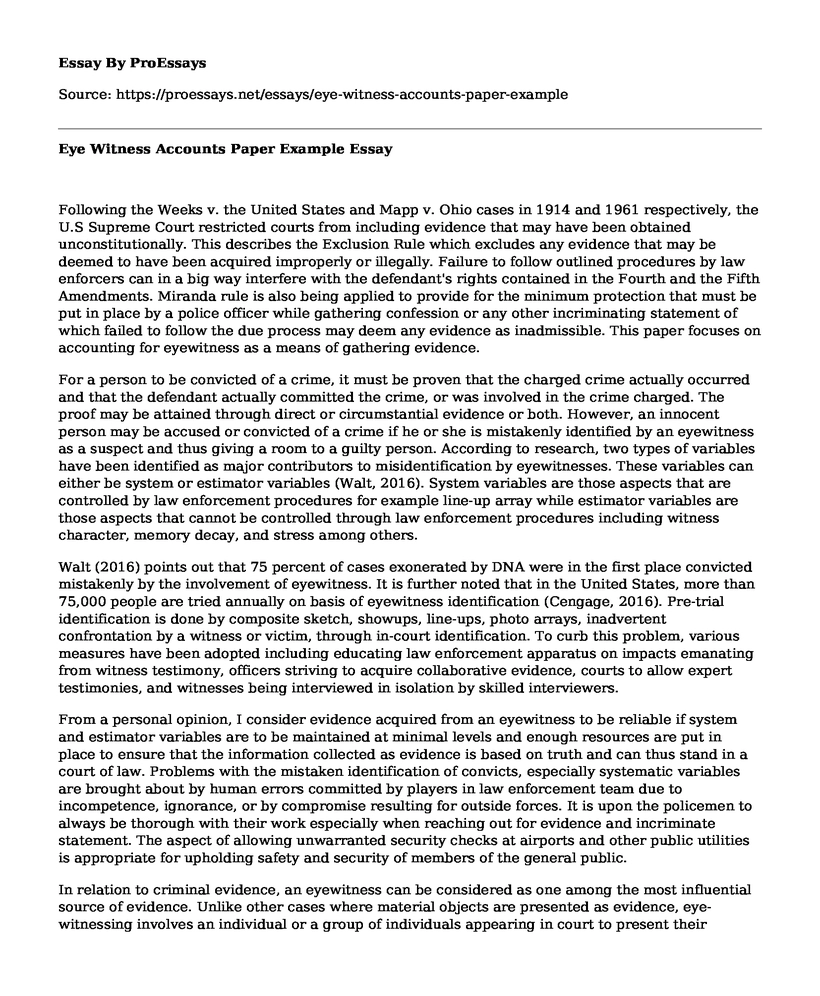Following the Weeks v. the United States and Mapp v. Ohio cases in 1914 and 1961 respectively, the U.S Supreme Court restricted courts from including evidence that may have been obtained unconstitutionally. This describes the Exclusion Rule which excludes any evidence that may be deemed to have been acquired improperly or illegally. Failure to follow outlined procedures by law enforcers can in a big way interfere with the defendant's rights contained in the Fourth and the Fifth Amendments. Miranda rule is also being applied to provide for the minimum protection that must be put in place by a police officer while gathering confession or any other incriminating statement of which failed to follow the due process may deem any evidence as inadmissible. This paper focuses on accounting for eyewitness as a means of gathering evidence.
For a person to be convicted of a crime, it must be proven that the charged crime actually occurred and that the defendant actually committed the crime, or was involved in the crime charged. The proof may be attained through direct or circumstantial evidence or both. However, an innocent person may be accused or convicted of a crime if he or she is mistakenly identified by an eyewitness as a suspect and thus giving a room to a guilty person. According to research, two types of variables have been identified as major contributors to misidentification by eyewitnesses. These variables can either be system or estimator variables (Walt, 2016). System variables are those aspects that are controlled by law enforcement procedures for example line-up array while estimator variables are those aspects that cannot be controlled through law enforcement procedures including witness character, memory decay, and stress among others.
Walt (2016) points out that 75 percent of cases exonerated by DNA were in the first place convicted mistakenly by the involvement of eyewitness. It is further noted that in the United States, more than 75,000 people are tried annually on basis of eyewitness identification (Cengage, 2016). Pre-trial identification is done by composite sketch, showups, line-ups, photo arrays, inadvertent confrontation by a witness or victim, through in-court identification. To curb this problem, various measures have been adopted including educating law enforcement apparatus on impacts emanating from witness testimony, officers striving to acquire collaborative evidence, courts to allow expert testimonies, and witnesses being interviewed in isolation by skilled interviewers.
From a personal opinion, I consider evidence acquired from an eyewitness to be reliable if system and estimator variables are to be maintained at minimal levels and enough resources are put in place to ensure that the information collected as evidence is based on truth and can thus stand in a court of law. Problems with the mistaken identification of convicts, especially systematic variables are brought about by human errors committed by players in law enforcement team due to incompetence, ignorance, or by compromise resulting for outside forces. It is upon the policemen to always be thorough with their work especially when reaching out for evidence and incriminate statement. The aspect of allowing unwarranted security checks at airports and other public utilities is appropriate for upholding safety and security of members of the general public.
In relation to criminal evidence, an eyewitness can be considered as one among the most influential source of evidence. Unlike other cases where material objects are presented as evidence, eye-witnessing involves an individual or a group of individuals appearing in court to present their testimony that incriminates a suspected convict. Therefore, investigators employ any available witness to provide information that will lead to even the slightest hint of how a crime occurred because a reliable witness is easier to source evidence from, instead of going through a process of examining material objects. However, evidence-based on eyewitness is prone to influence by the character of the witness and other earlier mentioned variables and in recent past have lost popularity based on DNA tests.
References
Gardener, T. J., & Anderson, M. T., (2016). Criminal Evidence: Principles and Cases. 9th Edition. Cengage. ISBN: 978-1-285-45900-4
Walt, L. (2016). "Judicial Understanding of the Reliability of Eyewitness Evidence: A Tale of Two Cases". PER/PELJ2016(19). DOI: http://dx.doi.org/10.17159/1727-3781/2016/v19i0a11601247
Cite this page
Eye Witness Accounts Paper Example. (2022, May 17). Retrieved from https://proessays.net/essays/eye-witness-accounts-paper-example
If you are the original author of this essay and no longer wish to have it published on the ProEssays website, please click below to request its removal:
- Clinton's United Nations 4Th World Conference Speech
- Cyrus the Great and the Cyrus Cylinder Essay
- Witness Interference Essay Draft Example
- Crime-Related Fear - Essay Sample
- Defendant's Reckless Act Proportional to Intentional Murder: States' Laws on Dangerous Dogs - Essay Sample
- Paper Example on Washington Supreme Court: Rule of Law & Court Structure
- Bureaucracy in Kafka's Novel - Book Review Sample







